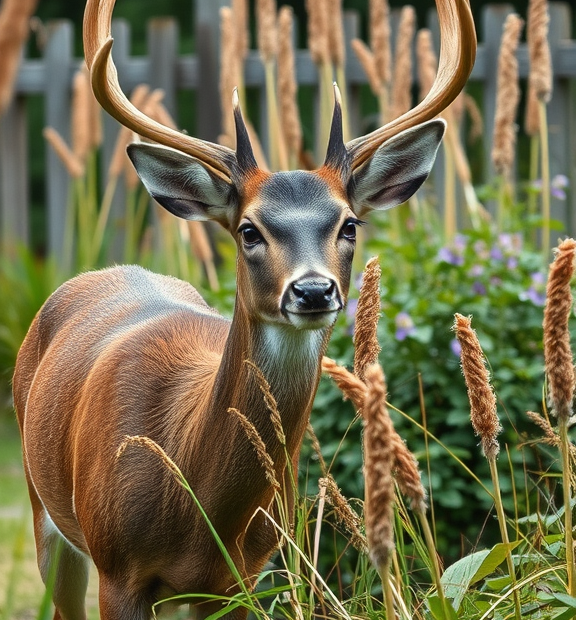Effective Strategies to Keep Deer Out of Your Garden
Deer can be a gardener’s worst nightmare, munching on your carefully tended plants and leaving devastation in their wake. If you’re tired of sharing your garden with these magnificent yet destructive creatures, there are several proven strategies to keep deer out. You can maintain the beauty of your garden while safeguarding your plants with a little creativity and effort.
Understanding Deer Behavior
Before implementing strategies, it’s essential to understand deer behavior. Deer are opportunistic feeders that are drawn to gardens for their lush greens, colorful flowers, and tasty vegetables. They are most active during dawn and dusk, so safeguarding your garden during these peak times can be particularly effective.
Physical Barriers
One of the most effective ways to keep deer out of your garden is by installing physical barriers. Here are some options to consider:
- Fencing: A solid fence at least 8 feet tall will deter most deer. Ensure the fence is sturdy; deer can easily jump over shorter heights or squeeze through weak spots. A slanted or double fence can add extra protection.
- Netting: For smaller gardens or specific plants, using netting can protect your most vulnerable varieties. Make sure the netting is securely anchored to the ground to prevent deer from ducking underneath.
- Raised Beds: Elevating your plants can make it harder for deer to reach them. Constructing raised beds not only adds visual interest to your garden but also makes it less accessible for deer.
Repellents
There are numerous deer repellents you can use to make your garden less attractive:
- Commercial Repellents: These products often include ingredients like predator urine or strong scents that deer find off-putting. Regular applications can help keep the deer at bay.
- Homemade Solutions: Consider concocting your own repellent using ingredients like garlic, hot peppers, or vinegar. Spray these around your garden to create an unfavorable environment for deer.
- Motion-Activated Sprays: Installing devices that spray water when they detect movement can startle deer and deter them from coming back.
Plant Selection
Choosing the right plants for your garden can also help minimize deer problems. Opt for deer-resistant varieties that are less appealing to these animals. Some examples of such plants include:
- Lavender: Its strong aroma is pleasant to humans but often off-putting to deer.
- Rosemary: This herbathy plant not only adds flavor to your meals but also keeps deer at bay.
- Ferns: Most deer shy away from dense foliage, making ferns a great addition to your garden.
Researching which plants deer typically avoid can save you time and heartache in the long run.
Making Your Garden Less Attractive
In addition to fencing and repellents, you can alter your garden environment to deter deer:
- Remove Food Sources: Keep your garden free from fallen fruits or vegetable debris that may attract deer. Regularly clean up any leftovers.
- Use Noisy Objects: Hanging wind chimes, old CDs, or aluminum foil strips can create sounds and movements that frighten deer away.
- Plant in Clusters: Instead of having your favorite plants isolated, group them together. This can create a more challenging scenario for deer, as they prefer open spaces for easy access.
Community Engagement
Love what I do? Be a hero and help me keep creating awesome content!
Support My Mission Now!Every donation fuels more great stuff – thank you, legend!
If you live in an area known for deer problems, consider joining forces with your neighbors. A community effort to manage deer populations through education, shared resources, and combined fencing measures can make a significant difference.
With determination and the right strategies, you can enjoy a thriving garden without the threat of deer destroying your hard work. Implementing physical barriers, using repellents, selecting deer-resistant plants, and creating an unfavorable environment will help you keep deer at bay. Your garden can remain the flourishing sanctuary you envision, free from unwanted visitors.
Understanding Deer Behavior to Protect Your Plants
Love what I do? Be a hero and help me keep creating awesome content!
Support My Mission Now!Every donation fuels more great stuff – thank you, legend!
Understanding deer behavior is essential for anyone who loves gardening. Knowing how deer think and move can help you protect your plants effectively. These beautiful creatures are often attracted to gardens, especially when they are looking for food. By learning about their habits, you can take steps to keep them away.
Why Deer Love Gardens
Deer are herbivores, which means they primarily eat plants. Your garden offers a feast of tasty treats that can be hard for them to resist. Here are a few reasons why deer are drawn to your garden:
- Green Foliage: Deer enjoy a variety of plants, especially tender shoots and leaves.
- Fruits and Vegetables: Gardens filled with fruits and vegetables are particularly appealing during the growing season.
- Cover: Gardens provide shelter and a safe space for deer.
When Do Deer Visit Gardens?
Timing is important. Deer are mainly active during dawn and dusk. They feel safest when it’s dark. If you notice deer damage early in the morning or late in the evening, this is likely when they are exploring your garden. Understanding their schedule can help you know when to take extra precautions.
Deer Communication
Love what I do? Be a hero and help me keep creating awesome content!
Support My Mission Now!Every donation fuels more great stuff – thank you, legend!
Deer communicate with each other through sounds, body language, and scents. Grunts and bleats are common vocalizations, while posturing can show their mood. When you understand how they communicate, you can better interpret their behavior. For example:
- If you see deer show their tail or ears back, they might feel threatened.
- In groups, they often stay alert and watch for danger together.
Using Deer Behavior to Your Advantage
Knowing how deer behave can help you design an effective strategy to protect your garden. Here are some strategies that work well:
- Plant Distasteful Plants: Use plants that deer usually avoid, such as lavender or marigolds. These can act as a natural deterrent.
- Fencing: A sturdy fence can keep deer away. Make sure it’s at least 8 feet tall, as deer can jump high.
- Scents: Use scents that deer dislike, such as garlic, hot pepper, or predator urine. These can mask the smell of your plants.
- Noise Makers: Wind chimes or motion-activated noise devices can scare off deer when they approach.
Creating a Deer-Resistant Garden
Love what I do? Be a hero and help me keep creating awesome content!
Support My Mission Now!Every donation fuels more great stuff – thank you, legend!
If you want to keep deer away, create a garden that’s less appealing. Here are some tips:
- Use Raised Beds: Raised garden beds are harder for deer to reach.
- Interplanting: Mixing desirable plants with less tasty ones confuses deer.
- Regular Movement: Commercial repellents work best when applied regularly and moved around your garden.
Monitoring Deer Activity
Keep an eye out for deer tracks or droppings. This can give you clues about their paths and habits. You can also set up motion-sensitive cameras to see their activity in your garden. These cameras can help you identify the times and the number of deer visiting, allowing you to adapt your strategies accordingly.
Understanding Seasonal Changes
Deer behavior changes with the seasons. In early spring, they may consume emerging plants, while in late summer, they may seek out fruits and vegetables. Knowing these seasonal changes can help you prepare your garden defenses accordingly. This ensures you are always a step ahead.
Keeping deer out of your garden requires some understanding of their behavior and habits. By applying these strategies, you can create an environment where your plants thrive and deer are less likely to invade. With a little effort and creativity, you can enjoy a flourishing garden free from deer damage.
Conclusion
Keeping deer out of your garden requires a combination of effective strategies and understanding deer behavior. By implementing the right techniques, you can create a protective environment for your plants.
First, physical barriers, such as fences, can be a strong deterrent. Ensure that your fence is high enough, ideally 8 feet or more, as deer are skilled jumpers. To enhance your defense against these persistent animals, consider adding motion-activated sprinkler systems or noise devices that startle them and keep them away.
Next, knowing deer habits can significantly boost your success. Deer are creatures of habit, often returning to areas with easy food sources. By rotating what you plant and using deer-resistant varieties, you can help protect your garden. Additionally, planting strong-scented herbs, such as lavender or mint, can mask the aroma of your vegetables and flowers, making them less enticing.
Utilizing repellents can also be beneficial, especially when combined with other methods. Commercial deer repellents are available, but homemade solutions involving strong scents—like garlic or chili powder—can be just as effective and more cost-efficient.
In most cases, a multi-faceted approach yields the best results. By integrating various strategies tailored specifically to your garden and the deer population in your area, you can create a vibrant and thriving garden. By understanding the behaviors of deer and applying these tactics, you can enjoy your garden year-round without the worry of unwanted visitors munching on your hard-earned plants. With some patience and creativity, you’ll find the perfect balance that protects your blooms and veggies while allowing you to relish in the beauty of your outdoor space.

